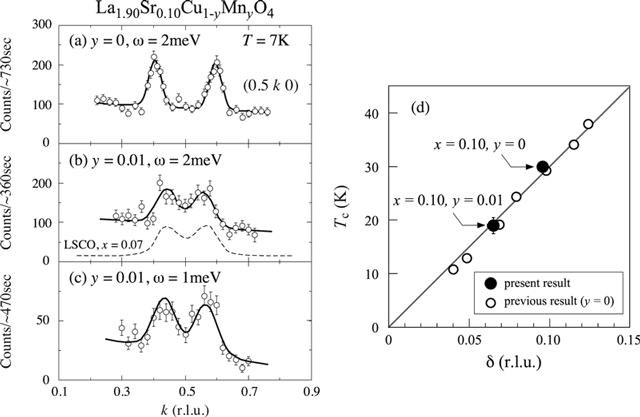PC11-4
The interplay between incommensurate spin correlations and superconductivity in Mn-substituted La1.90Sr0.10CuO4
*Masaki Fujita1
- Institute for Materials Research, Tohoku University1
The relationship between spin correlations and superconductivity in cuprate oxide has been studied for a long time. It is known that the underdoped (UD) La2-xSrxCuO4 (LSCO) exhibits low-energy magnetic fluctuations centered at incommensurate (IC) positions ((0.5±δ, 0.5, 0) and (0.5, 0.5±δ, 0)) in the reciprocal lattice space. The incommensurability (δ) linearly increases upon hole-doping, and superconducting (SC) transition temperature (Tc) in the UD region is proportional to the value of δ. Furthermore, the IC low-energy spin fluctuations in the overdoped region concomitantly diminish with the decrease of Tc. Thus, according to the hole concentration (p), spin fluctuations are connected with superconductivity in the entire SC phase. In order to better understand the characteristics of spin correlations, the impurity substitution effects have been intensively studied. In contrast to the rapid suppression of both Tc and the SC volume fraction of the sample (Vc) by Ni and Fe substitution, Tc in LSCO with fixed p is weakly suppressed by Mn substitution, while Vc decreases as in Fe substitution. Therefore, the magnetic impurity effect on the spin correlations different from other 3d transition metals and the relevance to superconductivity could be investigated in Mn substituted LSCO.
In this study, the low-energy spin fluctuations at 1-2 meV and static spin correlations were examined for a single crystal of UD La0.19Sr0.10Cu1-yMnyO4 with y = 0 and 0.01 by neutron scattering measurements. The y = 0.01 sample shows IC spin fluctuations with δ = 0.065 ± 0.003 reciprocal lattice units (r.l.u.), which is smaller than δ = 0.096 ± 0.001 r.l.u. in the pristine LSCO. The reduction of δ due to 1% Mn substitution (0.031 r.l.u.) is larger than that expected from a relation of δ = p and the carrier capture (0.01 r.l.u. per one hole) associated with the difference in the valences of Mn3+(Mn4+) and Cu2+ ions. Therefore, the Mn substitution effect has other factors that reduce δ besides the reduction of p. Meanwhile, the onset value of Tc (~19 K) and δ in the y = 0.01sample follow the linear relation between the two values reported for LSCO. The results following the δ-Tc relation for pristine LSCO suggest that the spin correlations modified through Mn substitution are directly connected with superconductivity. Furthermore, it was clarified that the ordering temperature of the static IC magnetic phase in the y = 0.01 sample is much higher than that for the UD region of pristine LSCO. Therefore, superconductivity coexists with the magnetically ordered phase, of which stability is statistically enhanced by Mn substitution.
Keywords: LSCO, neutron scattering, spin correlations
